Featured Application
Identification of fake violins.
Abstract
The paper presents the authentication of a Stradivari 1737 type violin, which belonged to the Romanian scientist Ştefan Odobleja. The analytical methods used in the study for assessing archaeometric characteristics of some component materials, along with the white degree and glycolysis rate measurements of the label that allowed an extensive evaluation of the violin, were OM, SEM–EDX, and micro-FTIR. The preparation binder (egg white from thin gypsum layers) and the varnish (identification of linseed oil and colophony components, alongside contamination impurities) were assessed in order to evaluate the artefact conservation state, as well as the restoration and counterfeiting interventions. We can conclude that the violin was done by a violin maker from the Stradivari family, and it is a replica of the violins of that period.
1. Introduction
The authentication of an ancient violin requires a series of data regarding the history of the violin (itineraries travelled, users/owners, periods and its players, preservation–restoration interventions, etc.), the structural and functional characteristics (size, typological framing, and structural changes), the establishment of the conservation state, previous authentications (with the expert’s notation), and the identification of certain archaeometric characteristics and their assessment through the chemometric corroboration of the multi-analytical data. This complex approach is very often used for extensive expert examinations and characterizations of old violins [1,2]. Authentication means more than dating and establishing the manufacturer. By authentication, the following can be determined, in addition to the manufacturing date and the workshop/author: a series of attributes concerning the historical context, interventions after the manufacturing, structural–functional and aesthetic/artistic changes, the owner/custodian, transfers, the period of use, and many others.
It is known that, since 1539 and up until 1752, Cremona witnessed the creation of a series of violins that surpassed in quality those from Tirol or elsewhere in Europe. Even from the early stages of this period, Cremona’s violins became very attractive across the world, being the most sought-after stringed instruments and universally recognized as true works of art.
Sorted chronologically, the most famous Cremonese violin makers were members of the following families: the Amati (starting with Andrea Amati, 1505–1578, whose 1558 violin kept by the Metropolitan Museum of Art is considered one of the oldest of its kind in the world, followed by his sons Antonio, 1537–1607, and Girolamo, 1551–1630, who developed the violin design, position, size, and shape, then Girolamo’s son Nicola or Nicolò/Nicolao, 1596–1684, the most prominent member of the Amati family, followed by Nicola’s son Girolamo/Hieronymus II, 1649–1740), the Stradivari (Antonio, 1644–1737 and his two sons Francesco, 1671–1743 and Omobono, 1679–1742), the Bergonzi (Carlo, 1683–1747, followed by his two sons Michele Angelo, 1722–1758 and Zosimo, 1725–1777, then the sons of the latter, Nicola, 1746–1796 and Carlo II, 1758–1838), and the Guarneri (Andrea, 1626–1698, an apprentice of Nicolo Amati between 1641 and 1646, and member of the Amati workshop between 1650 and 1654, followed by his sons Pietro Giovanni/Pietro da Mantova, 1655–1720 and Giuseppe Giovanni Battista, 1666–1740, then the sons of the latter, Pietro/Pietro da Venezia, 1695–1762, and the most famous of the Guarneris, Bartolomeo Giuseppe/del Gesùs, 1698–1744, whose labels on his violins had the cryptogram IHS = iota–eta–sigma, and who is considered the second greatest violin maker master after Antonio Stradivari).
Among these families, the Stradivari was and remains the most appreciated. Of the more than 6100 stringed instruments fashioned by the father and his two sons, 650 are currently known, and only a small number of them are being played, while most are being kept in museums or private collections. The Stradivari violin is stronger between 200 and 250 Hz and over 1.6 kHz; conversely, del Gesùs’ violin is stronger between 315 Hz and 1.25 kHz. These differences are perceived as crisper and stronger sounds for the Stradivari violins with low frequencies, and a darker sound for del Gesùs’ violins.
Stradivari’s well-known violins often bear the mark of size (“petit patron”, “grand patron”, “longuet”, “violli”, etc.), the period (early: “Hellier”, “Rode”, “Le Toscan”, “Greffulhe”; the apogee: “Mesia”, “The Song of the Swan”; and the end: “Joachim”), and the name of the village, institution, or artist/songwriter who played on it (Ernst, Alard, Belts, The Hammer, Lady Tennant, Davidov/Yo-Yo Ma, Duport/Rostropovici, Shaham/Countess Polignac, Paganini, etc.) [3,4].
The sound quality of an ancient violin was the result of both the wood and manufacturing technology, together with the combination of the finishing materials used [5].
The value of a violin is given by the mastery of the maker, age, and preservation status, but also by the keeper or the value of the master who was or is playing on it. An ancient violin is an invaluable piece of art on account of the finesse and beauty of its execution (especially the Stradivarians with exotic veneer inlays or ivory incrustations, etc.), the impeccable conservation state, and the quality of its sound. As such, it is an object to be rigorously protected [5,6,7,8,9].
Stradivarius violins have often been copied, some for illicit purposes, others in order to launch a violin model that was demanded by players. There are thousands of instruments that are copies of Stradivarius models. The McKinley Tariff Act from 1891 stipulates that any copy meant for the legal market must also bear information regarding the country of origin (Figure 1).
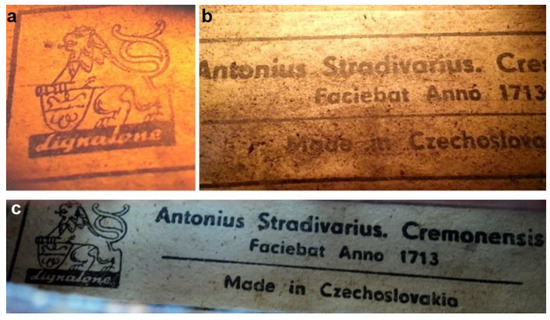
Figure 1.
Details (a,b) of the label (c) of a 1713 Stradivari violin, manufactured after 1891 by the Lignalone company in Czechoslovakia, which was examined in our laboratory.
It is known that a violin that is played remains in a better state of conservation than an unplayed one. Moreover, most of the violins that have survived to the present day have undergone restoration and revarnishing interventions of various magnitudes. Negligent or very intense/aggressive use of the violin leads to pre-collapse situations: longitudinal fractures at the level of the f-holes/worktop areas, or upper cover lid detachment, tab damage, cracking or erosion of the varnish in active areas (next to the chin or near the tongue and the throat), and other deterioration or evolving degradations requiring urgent restoration and reversal interventions [1,2,10,11,12,13,14,15,16].
The mechanisms of the deterioration effects on the physical state or degradation of the nature of the component materials can be elucidated by means of complex analyses using modern instrumental techniques [10,17,18,19,20].
At the same time, care should be taken to preserve the integrity of the instrument, especially when studying genuine, authentic, cultural heritage violins, requiring a non-invasive approach or by using in tests copies of the materials and manufacture technology used for the original instrument [5,17,18,19,20].
The aim of this paper is the authentication of the violin. This represents laborious work, requiring numerous studies, involving modern methods and techniques of investigation, in a system of co-assistance and corroboration, with consideration being given to determining the type or model of the violin by measurements of the functional and structural characteristics (Figure 2), then the determination of archaeometric characteristics of label, wood, and finishing materials (wood processing and treatment, variation of composition in stratigraphic and surface profiles of structural components) with an approximation of the age.
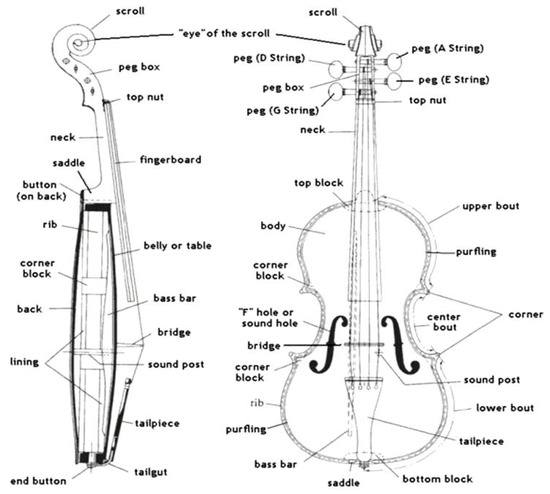
Figure 2.
The functional and structural components used in evaluation of violin type/model [21].
2. Experimental
2.1. Violin History
The violin belonged to Ştefan Odobleja (deceased in 1978; elected member of the Romanian Academy post-mortem in 1990), a Romanian military doctor, scientist, and founder of cybernetics. According to the current owner’s father, the violin came from a German-led railway transport destined for Germany, which derailed at Balota, Romania in 1916. In the wagon where the violin was found there were also paintings, books, and other cultural heritage items. At the news of derailment of the train, many of the villagers from Huțului Valley (Valea Huțului—the village now bears the name of the scientist), most of them young people, went to the scene of the accident. Among them was the young Ştefan Odobleja, together with his older brother Dumitru, who took from a wagon some beautiful books related to medicine, books in English, German, and French, a few paintings, and one violin. Regretfully, Ştefan Odobleja’s house burned in 1973, and many of these things preserved since the accident were destroyed by fire. The violin (Figure 3) and part of the medicine book collection were saved as they were kept in a campaign armored box with an automatic locking system, in a hall opposite to the burned area. The violin was given as an inheritance from Ștefan Odobleja, to the older son Ștefan in 1978, three weeks before the death of his father. Ştefan Odobleja played the violin until 1978.
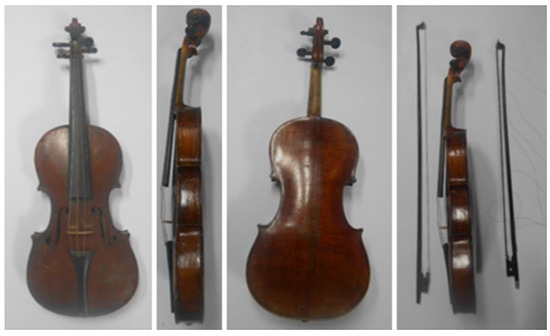
Figure 3.
The images of the violin.
The owners tried to authenticate the violin in the past but did not have the money for it. Due to its poor state of conservation, many years ago the owner sent it to a craftsman, named Bărbulescu from Bucharest, who after a preliminary examination applied a stamp, in order to give permission for the violin to cross the border or be sold in auctions. Craftsman Bărbulescu gave him a certificate of his expertise. So far, there has been no question of selling, but because of its poor state of conservation, the owner wanted to make an expert authentication prior to restoration.
2.2. The Structural Size of the Violin
The diameter of the lower bout (B) (according to the structure presented in Figure 2) is 205 mm (195 mm between the black lines); the diameter of the upper bout (C) is 164 mm; the width of the ribs at the tailpiece (D) are 39/30 mm; the width of the ribs at the neck (E) are 39/32 mm; the length of the body or the resonance box (A) are 354/348 mm; the length of the f-holes is 75 mm; the diameter of the large circle of the left/right f-hole is 8/8 mm; the diameter of the small circle of the left/right f-hole is 7/7 mm; the distance between the notches is 10 mm; the opening of the f-holes is 6 mm; the minimum distance at the end of the f-holes is ~2.0/2.0 mm; the edges of the f-holes according to model 1721–1730 (the specific violin dated to 1723); the distance at the level of the f-holes of the resonance box is 111 mm; the width of the resonance box: 55 mm; the length of the fingerboard is 272 mm (middle model); the width of the fingerboard is 4 mm; the neck joint is 4 mm; the length of the neck plus the scroll is 235 mm; the maximum width of the scroll is 11 mm; the quadrature of the scroll is 7 mm; the central thickness is 41 mm; the thickens of the scroll at the support plate is 22 mm; the distance in the pit towards the plate is 19 mm; the distance in the pit towards the scroll is 11 mm; and the depth of the pit is 22.01 mm.
2.3. The State of Preservation
In the violin resonance box, next to the ribbon, there is a two-line label reading “Antonius Stradivarius Cremonensis/Faciebat anno 1723″ and in the lower left, the double concentric circle with a center-cross, with the mark “AS” on the base (Figure 4).
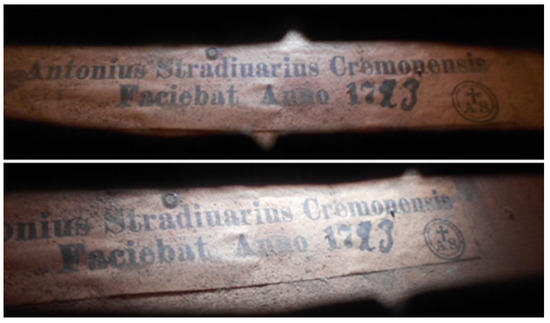
Figure 4.
Images of the label, highlighting the loose contour and the alveoli.
The last two digits of the year are handwritten with black ink, much later than the original graphs of the label. The blurriness of the number 2 is conspicuous; it may be a ‘2’ over a ‘7’ or a ‘9’, but this is uncertain since the violin would thus surpass the actual period of manufacturing, while the number 3 comes out of the frame and is written sloppily. The label has the corners cut out evenly and has no contour. The printing ink is weakly fragile, demonstrating that the binder has degraded slightly, with graphs showing slight traces of cracking and expansion. The label has fringed edges, it is detached in some areas, and has traces of microbiological contamination. In this case we are dealing with an unsuccessful attempt to counterfeit the manufacture date, in order to assign it to the period 1719–1727, considered by experts to be the period of master achievements of the violin maker.
The violin is in a poor conservation state, with many interventions on the caps. There are many deteriorations and degradations of the varnish and of the wood support (longitudinal cracks and cracks on the joint of the lower plate). Most of the damage is the result of manipulation: scratching and erosion of the varnish in the chin area and on the area of the arch. The fouling of the varnish, in the form of darkening of the patina, is extensive, especially on the top plate because of colophony deposits, skin fat, sweat, etc. The bridge of the violin is missing, and the strings are not original (Figure 5).
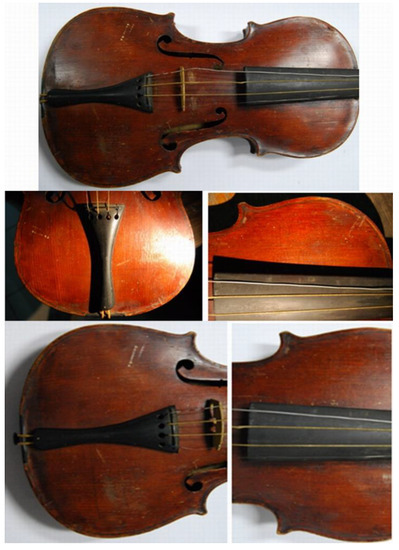
Figure 5.
Details with damage and degradation of the top cover.
There are old traces of intervention on the resonance box plates, easily recognizable from the traces of excess adhesive (animal glue) and scratches revealed by UV reflection, both inside the box and in the area of the ribs. There are deep iridescences and varnish lacunae due to friction in the area under the bridge.
Both the lower and the top plates are made of two boards, and the central joint area is well defined due to a contraction crack in the bottom plate. The top plate is made of spruce and has large annual rings with a thickness between 1.0 and 3.0 mm.
Around the lower bouts the rings retain their parallelism, as well as in the small upper bout. There are many erosions from use in the area of the f-holes, neck, and chin. The neck, ribs, and the backplate are made of maple wood.
The backplate is strongly scratched and has a deep longitudinal crack in the center, and the varnish is affected in limited areas.
There are a lot of fouling traces in the areas on both sides of the bridge. The mesh retains the parallelism of the lines, being produced by burning. The corners are very well preserved. The violin was played only before 1978. The model of the f-holes is found in the Stradivarius violins of 1727–1738.
Under the stereomicroscope, the inner surface of the resonance box has a patina visible with the naked eye, which seems to have been cleaned from non-adherent and semi-adherent particles sometimes before the First World War.
The UV reflection shows that the varnish is thick and old, and while the protein binder from the dressing cannot be easily observed, there is a slight fluorescence in the areas of binder based on egg white, gypsum, and colophony.
The ribs, numbering six (two in the upper bout, two in the middle, and two in the lower bout), are made of maple wood and have a width roughly equal around the entire perimeter of the violin, and according to the patina are as old as the front and rear panels, proving that they were not changed when the violin was dismantled. Moreover, the inner junction cord was not changed at the time of the last reclosing of the resonance box (performed a long time before World War I). When the violin was manufactured, the two plates were mounted on the already glued edges, on the ends of the hubs in the four corners of the lids, with the flexible tape of wood, which were already fixed in the hubs and corners by piling and gluing. All these structural elements have the same age as the front panel, back panel, and ribs.
The mesh incrustations are uniform and equidistant to the edges, being very thinly and flexibly pyro engraved. The neck is made of maple wood, with a volute or scroll fashioned moderately, while the dimensions correspond to a Stradivarius violin from 1727–1738, the late period, with violins with lesser mastery.
2.4. Methods Involved
For authenticating the violin, the label’s age patina was studied, and the year of manufacturing was estimated evaluating the white degree and the glycolysis rate of the label using patented methods [22,23], in conjunction with data obtained from the composition and degradation status of the varnish (protective lacquer), by the involvement of two complementary techniques of analysis (SEM–EDX produced by Vega Tescan, Brno, Czech Republic and micro-FTIR by Bruker Optic, Berlin, Germany). Estimating the age of the label was done by determining the white degree [1,22] and by the rate of glycolysis [23,24,25,26].
2.5. Determining the Age of the Label by White Degree
The method consists in determining the age of the paper substrate based on the variation degree of whiteness, in correlation with the type of cellulosic material used. The sample was exposed to artificial aging by thermally controlled temperature at 103 ± 2 °C in predefine time intervals [1,22] and white degree measurement. The values obtained were extrapolated on the calibration curve, determining the natural aging time corresponding to the age of the respective material.
2.6. Determining the Age of the Label by Glycolysis Rate
The second method for determining the age of the label consisted of determining the degree of polymerization by the viscosimetric method [23,24,25,26], based on the rate of glycolysis, which varies in proportion to the length using the calibration curve for the cellulosic material from a mixture of recycled cotton, linen, or hemp with known age. The method was patented and calibrated in the research laboratory of Alexandru Ioan Cuza University of Iasi.
For this, a 2 × 4 mm sample of the label, weighing ca. 3 mg, was dissolved in 10 mL, 0.5 M cuproxane alkaline solution, yielding a concentration of 3 g sample/L solution, for which the specific polymerization degree was determined based on specific dynamic viscosity at 20 °C using a digital viscosimeter (made by Auxilab), equipped with a thermostat system at 20 ± 0.05 °C. The percentage of broken glycosidic bonds, denoted by Δ(%), for time (age) t, in years, was calculated according to the following formula:
where (GP)i represents the degree of polymerization for new cotton (for example new cotton is equal to 1800 and for new mixture approx. 3100), and (GP)f is the degree of polymerization determined for the old cellulosic support. Based on its Δ(%), assessed by the above relationship, for the sample taken in the study, the age in years was established by extrapolation based on the standard curve [23,24,25,26].
Δ(%) = 100(2/(GP)f − 2/(GP)i)
Cuproxane is an ammoniacal complex of Cu(II), in the form of a hydroxide, with the chemical name tetrammino dihydroxide Cu(II), which in alkaline aqueous media dissolves cellulose to form a soluble complex with the combination ratio C6H10O5:Cu = 2:1, according to the following reaction [26]:
2C6H7O2(OH)3 + (Cu(NH3)4)(OH)2 → (Cu(NH3)4)2+(C6H7O2(OH)2O)2− + 2H2O
For the calculation of the amount of cellulose, the amount of sample to be dissolved in the cupro-ammonia solution was determined using the following formula:
where V is the useful volume of the cup containing the cuproxane solution in which cellulose is dissolved (cm3), C is the concentration of cellulose in the solution (g/L), and W is the cellulosic moisture (%).
g = 100 × V × C/1000 × (100 − W) = V × C/(1000 − 10W)
The specific viscosity of the cellulose solution was calculated as follows:
where t0 is the drain time of the cuproxane solution, and t1 is the drain time of the cuproxane solution containing the dissolved cellulose, determined by timing to viscosity measurement.
ηsp = t1/t0 − 1
The degree of polymerization, G.P., was calculated as
where c is the cellulose concentration in g/L in the 0.5 M cuproxane solution.
G.P. = 2000 ηsp/c(1 + 0.29ηsp)
The age (y) was estimated according to the etalon curve (glycolise rate/age), where there were highlighted 2 slope changes, the first for Δ%, x = from 0 to 0.145 (Equation (6)), and the second for Δ%, x = 0.152 to 0.170 (Equation (7)).
where x = Δ% and y = age (years).
y = 1425.7539 × x − 1.1924
y = 22,142.8571 × x − 3144.7619
The method can approximate the age of the cellulose support with a precision of ±5 years.
2.7. Determination of the Archaeometric Characteristics of Varnish and Other Finishing Materials
For this study, two micro-samples were taken with a scalpel from the areas that did not show any evidence of retouches or repairs, but in which there was a visible difference between the areas with old varnish and those with later re-varnishing.
Optical microscopy (OM) was performed using a Carl Zeiss Axio Imager A1m having a camera attached. Variable sizes were captured. Based on OM photomicrographs, representative areas were selected for SEM–EDX and micro-FTIR analysis.
SEM–EDX was done using an electronic scanning microscope, the SEM model VEGA II LSH, produced by TESCAN Czech Republic, coupled with an EDX type QUANTAX QX2 detector, produced by BRUKER/ROENTEC Germany.
The fully controlled microscope has a tungsten filament electron canon that can achieve a resolution of 3 nm at 30 kV, with magnification between 30× and 1,000,000× in “resolution” operating mode, the acceleration voltage between 200 V at 30 kV, and the scanning speed between 200 ns and 10 ms per pixel. Working pressure is less than 1 × 10−2 Pa. The image obtained may be constituted by secondary electrons (SE) or back scattering electrons (BSE).
The Quantax QX2 is an EDX detector used for qualitative and quantitative micro-analysis. The EDX detector is the third-generation, X-flash type, which does not need liquid nitrogen cooling and is approx. 10 times faster than conventional Si (Li) detectors.
The technique, along with the photomicrograph visualization, allows the image to be rendered with the mapping of the atoms on the researched surface, and based on the X-ray spectrum the determination of the elemental composition (in gravimetric or molar percentage) of a microstructure or selected area and the evaluation of the variation of the composition along a vector arranged in the analyzed or selected area.
Micro-FTIR spectra were recorded with an FTIR spectrophotometer coupled with a HYPERION 1000 microscope, both from Bruker Optic, Berlin, Germany.
The FTIR spectrophotometer used was the TENSOR type 27, which is particularly suitable for close IR measurements. The standard detector is a DLaTGS covering the spectral range 7500–370 cm−1 and operating at room temperature. The resolution is typically 4 cm−1 but can also reach 1 cm−1. The TENSOR 27 is equipped with a He–Ne laser emitting at 633 nm and at a power of 1 mW and showing a ROCKSOLID alignment of the interferometer. The signal/noise ratio of this device is very good. The TENSOR is fully controlled by the OPUS software provided by the Bruker manufacturing company.
The HYPERION 1000 microscope is an accessory that can be coupled to almost any Bruker FTIR spectrophotometer. For non-destructive measurements, the TENSOR 27 spectrometer is coupled with the HYPERION 1000 microscope, and usually solid-state samples are working in reflection.
The software used was OPUS/VIDEO for interactive video data acquisition. It can work both in transmission and reflection. The MCT detector was a liquid-cooled MCT (−196 °C).
The spectral range was 600–7500 cm−1 and the measured area was optimized at a diameter of 250 μm with the possibility of reaching a minimum of 20 μm. The microscope was equipped with a 15× lens.
3. Results and Discussions
3.1. Dating the Label by White Degree
In this regard, three samples of 0.4 cm2 were cut from different areas on the edge of the label. After determining the degree of whiteness using the measurement of white degree, they were heat treated in a thermoregulation oven at 103 ± 2 °C for 3 h, after which the whiteness was again determined. Three times the aging process on the same samples was repeated for a further 3 h, after which it was determined from the white grade to equate a 12-h period of the standard curve (Figure 6).
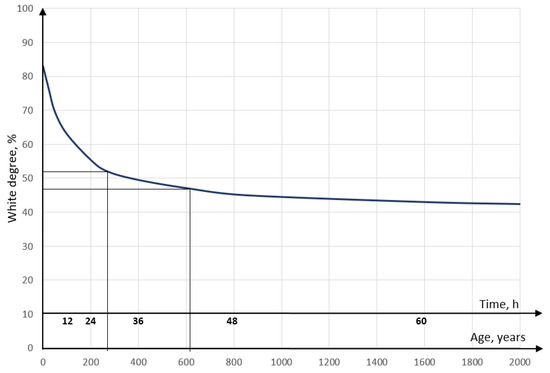
Figure 6.
White degree standard curve.
The initial value of white was 52%, and after the four stages of artificial aging for 3 h, it fell to 47%. By extrapolation on the standard curve, the evaluated segment was between 270 and 610 years old, the commissioning time being less than 275 ± 10 years. Since this method was used only for approximation, we used a secondary method for validation, evaluating the age from the glycolysis rate.
3.2. Dating the Label by Glycolysis Rate
Regarding the evaluation of the glycolysis rate from the degree of polymerization determined by the kinematic/dynamic viscosity method, the leakage time of the solutions in the digital viscometer was determined. The viscosity measurement operation was repeated at least three times. Based on average values of Δ% as approx. 0.155, according to Equation (7), the approximate value for the age of the label was 287 ± 5 years.
3.3. Determination of the Archaeometric Characteristics of the Varnish and Other Component Finishing Materials
To determine the archaeometric characteristics of the varnish and other superficial materials from the first opening, from the post-operative re-varnishing and the anthropic contamination, two representative areas from the top plate were selected. From these two areas, with a scalpel, samples were taken and were analyzed by OM, SEM–EDX, and micro-FTIR. OM analysis (Figure 7) highlighted the difference of these two varnishes in terms of the uniformity of the distribution and conservation status of basic components and of surface or embedded impurities.
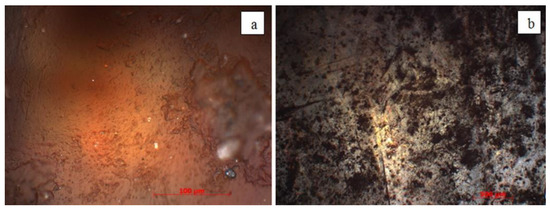
Figure 7.
Optical microscopy (OM) microphotographs: (a) new varnish; (b) old varnish.
SEM microphotographs (Figure 8) confirmed the net difference between these two varnishes, the conservation status and the uneven distribution and the morphology of the components and finishing materials, along with impurities from the anthropic contamination (including the fouling).
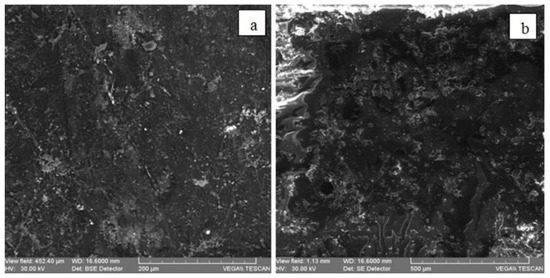
Figure 8.
SEM microphotographs: (a) new varnish; (b) old varnish.
By analyzing EDX spectra (Figure 9) the elemental composition was determined and basic components of the two varnishes were identified, along with the identification of a series of inorganic substances. Thus, among the major components of the varnishes, the following were identified: carbon, silicon, aluminum, calcium, sulphur, and potassium. From the composition of impurities of anthropogenic contamination, sodium, magnesium, and chlorine were identified [8].
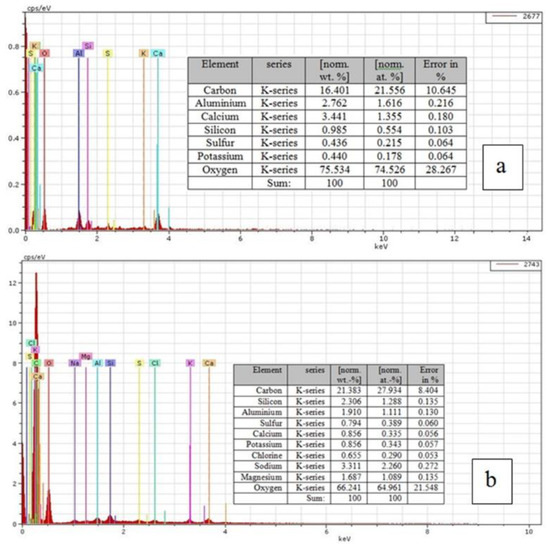
Figure 9.
EDX spectra and elemental composition: (a) new varnish; (b) old varnish.
The presence of carbon was caused by organic components (linseed oil, colophony, and egg whites) and carbonate anions, which were present in the form of traces in the preparation, along with calcium sulphate used for putting it into operation before the first varnishing. The other components were attributed to impurities in the form of traces such as colored earths from the preparation (red ultramarine) and anthropic contamination, which were more evident in the new varnish, in which the two groups were summed up. Thereby, the new varnish versus the old one showed a decrease of elemental concentrations of Al, Ca, and O, and an increase of C, Si, S, and K. Moreover, the old varnish additionally contained Mg, Na, and Cl from anthropic contamination from usage (perspiration and palmar–digital fingerprints). Results showed that the old varnish, with a preservation status corresponding to over 270 years old, was preserved under the new varnish, whose conservation status corresponded to an age of approx. 100 years. The violin was used mostly after the violin was put into operation until approx. 100 years ago. After the violin entered in the possession of Ştefan Odobleja (1918), he played on it for a very short period.
For the evaluation of the elementary distribution within the varnish samples, thorough investigation into the surface and stratigraphic structure was needed [7]. For this purpose, OM and SEM–EDX data were corroborated with FTIR results (Table 1).

Table 1.
IR bands for linseed oil and colophony (in cm−1).
Therefore, the presence of colored earths added as a pigment along with a number of other inorganic fillers could be easily differentiated from anthropic contaminants based on calcium, sodium, potassium, sulphur, and chlorine (from sweat and skin lipids) [27,28,29]. The ancient varnish used for musical instruments, often applied over a thin film of finely divided plaster and dispersed in egg white solution in water, contains fine colophony powder dispersed in siccative oils (boiled flax, hemp, poppy, or walnut) in ratios ranging from 2:1 to 3:1 [30]. It is known that mixtures of siccative oils and diterpenic resins (colophony derivatives), especially those of Pinaceae, were mostly used by Antonio Stradivari for his violins [5,6]. The main components of colophony are resinous monocarboxylic acids of alkyl hydro phenanthrene. These can be divided into two subgroups, namely pimaric and abietic type acids [13]. The basic difference between the two groups is in the substituent at the C-13 position, which is isopropyl in abietic acid and vinyl or methyl in pimaric acid [11,13]. The varnishes used by Stradivari have the ratio of 3:1 flax and colophony oil, with some dyes [6].
The old recipe was made as follows [31,32]: Pure linseed oil was heated to 270 °C, kept at this temperature for 3 h, and then cooled to 150 °C after which colophony was added; then this mixture was again heated to 250 °C for half an hour.
The conservability of these varnishes over time is dependent on the nature and the ratio of the main constituents, but also on the presence of other additives [15,16,17,18]. Being a hand-applied woodcutter film, the main causes of aging over time are contact with the acidic pH of the violinist’s skin, the combined effect of welding moisture, skin lipids, and human temperatures, as well as exposure to light, especially to the UV spectrum [9,29].
The chemical differences between the two varnishes existing on the violin (the old and the new varnish—subsequently applied) were studied using micro-FTIR spectroscopy, correlated with OM and SEM–EDX data, in order to determine the presence and the evolution of the different chemical components, respectively, and their state of preservation, in correlation with the period of re-varnishing after putting it into use.
Varnish samples from the last application (new varnish) inside the layer showed a series of aggregates, perhaps particles, which could have come either from undispersed colophony or from additives, while the old varnish had such aggregates only on the surface or in the interface with the new varnish (applied later). The new varnish in the stratigraphic structure was dark yellow, with black aggregates on the surface, derived from colophony or oil entrained by photo-oxidation, and the second (the old varnish) was colorless, with fine aggregates of light brown colophony.
As is known from the literature [33,34,35], when pure abietic acid is exposed to air, high temperature, or ultraviolet light, double-chromophore groups with a C=O connection disappear due to conjugation of π–σ (C–O). This phenomenon is due to the presence of colophony micro-aggregates, which induce a lower homogeneity of the thin film, with subsequent production of areas where the resin tends to become brown.
Moreover, a large amount of undispersed colophony could stop the polymerization of the linseed oil film integrally through the cross-linking process, resulting in the presence of a non-homogeneous layer that is less resistant to natural aging factors.
The chemical changes of the two varnishes, with different aging durations and causes, were evaluated from the micro-FTIR spectra for the two representative areas under study.
Significant differences between the three spectral bands could be observed, especially by analyzing peaks in the wavelength range between 1850 and 675 cm−1. Thus, a wide peak between 1100 and 1200 cm−1 was observed due to the overlapping of the two deformation bands of C–O groups from boiled linseed oil at 1083.19 cm−1 (new varnish) and 1090.48 cm−1 (old varnish) and 1123.72 cm−1 (new varnish) and 1122.46 cm−1 (old varnish), respectively, and colophony at 1166.92 cm−1 (new varnish) and 1172.84 cm−1 (old varnish), which became less symmetrical at the old varnish.
There were also differences in COH connections, which had a deformation peak representative of colophony at 897.70 cm−1 (old varnish) and 895.47 cm−1 (new varnish) and for C=C at 725.89 cm−1 (new varnish) and 740.57 cm−1 (old varnish). Of the two functional groups, the deformation vibrations of the COH connections were well differentiated, whereas in contrast, those of the C=C connections (carbon skeleton) were insignificant.
FTIR spectra suggested that boiled flax oil over time had an activating role in the oxidation reactions of colophony components, and colophony had a role in reducing cross-linking by polymerizing linseed oil at siccativation, and that the varnish conservation state was related to the composition of the two components, but also by the presence of other additives used to obtain it (especially the presence of the cations of the “s” blocks of metals, which led to the saponification of the active carboxylic groups). In fact, the concentration and distribution of colophony affected oil oxidation and vice versa.
From the literature [34,35,36,37], it is well known that there were peaks of the valence vibrations of the carbonyl group in the siccativated boiled linseed oil of 1738.30 cm−1 (the new varnish) and 1733.09 cm−1 (the old varnish), respectively, of the vinyl from colophony groups from 1662.96 cm−1 (new varnish) and from 1657.46 cm−1 (old varnish), both with the same displacement effect (the peaks modifying their asymmetry in the old varnish).
On the other hand, the old varnish, due to the oxidative fouling of the boiled linseed oil from the surface, protected the inner area of the film, which was visible on the deformation vibrations of the COH bond, from 811.50 cm−1, which was found only at the new varnish, and colophony from 897.70 cm−1 for the old varnish and 895.47 cm−1 for the new varnish.
The IR spectra highlighted, based on the functional groups of major chemical components, the presence of boiled linseed oil and colophony (triterpenic resins) in the varnish. For these two examined areas, slight displacements of the absorption bands were observed in relation to those presented in the literature.
The peaks of the old varnish were obviously much weaker than those of the new varnish, and the different peak values indicated different states of degradation of the two varnishes, with a difference of 100 years between them.
The difference between the conservation states of the two varnishes was given by the decrease of the peak intensities of the C–H group from the colophony from 2943.67 cm−1 (new varnish) with its displacement at 2903.31 cm−1 (old varnish) and, respectively, 2878.89 cm−1 (new varnish) at 2753.15 cm−1 (old varnish) and that of the C=C group at 1657.45 cm−1 (old varnish), which was attenuated and slightly displaced from 1662.95 cm−1 (new varnish), which was well-defined. Moreover, the increase in broadband intensity in the range of 3200–3400 cm−1 and the reduction to a single peak of 3455.64 cm−1 (new varnish), which shifted to 3449.86 cm−1 (the old varnish), was due to the aging natural process, by self-oxidation and cross-linking reactions, which heavily affected the polymer fraction of the boiled flax oil [12,32,38,39,40,41,42,43,44].
Significant differences could also be observed for the peaks corresponding to the amide groups I and II of the egg proteins (ν(CONH) and δ(CONH)), specific valency vibrations of 1513.28 cm−1 of the new varnish and 1512.20 cm−1 of the old varnish, than those of the 1428.89 cm−1 deformation from the new varnish and from 1429.26 cm−1 of the old varnish, respectively, to 1323.18 cm−1 and 1320.84 cm−1.
Since these proteins were under the first varnish layer, compared to the components of the varnish, they had not undergone major changes under the influence of natural aging processes.
The FTIR spectra, corroborating the EDX data, confirmed that the old varnish was from 1737, and the new one was from after 1860 but not later than 1914.
Moreover, both EDX and FTIR spectra allowed identification of the presence of a mineral interface (gypsum preparation and an aqueous binder based on egg proteins) between the wood support and the varnish layer applied before the first varnishing.
4. Conclusions
The violin under discussion is a Stradivari model 1727–1738, built by a violin maker from or a disciple of the Stradivari family, and it is a replica of the violins of that period, respecting all details and measurements.
The white degree and glycolysis rate measurements of the label are the basic elements in preliminary authentication, which confirms the age of over 280 years. In addition, UV, OM, EDX, and micro-FTIR examination reflected the presence of gypsum and egg counterparts in the preparation, and in the two varnishes of siccativated linseed oil and colophony, along with traces of anthropogenic contamination (sweating and tegumentary lipid fouling). The dating (date of manufacture) of the violin was done by two methods, namely the white degree and the glycolysis rate. The values obtained are, for the first method 275 ± 10 years, and for the second one 287 ± 5 years, and as an average value the age can be stated as 280 years.
In conclusion, the violin was made around 1735–1740, when the market value was much lower compared to 1711–1718 (most valuable violins) and 1719–1727 (average value) periods. This fact contributed to the counterfeiting of the original label by subsequently writing with black ink the number of the tenths over another blurry digit, this latter figure being handwritten unevenly and un-calligraphically. In this way, the violin maker tried to raise the value of the violin, writing the manufacturing age in a better period of Stradivarius, which was 1719–1727, than the real year of manufacturing.
The violin was used mainly until 1914, and after this time only occasionally, until 1978 when it became the property of the current owner. The violin was opened, restored, and re-varnished between 1860 and 1914, using the same old varnish recipe (known since Stradivarius’ time).
The violin belongs to the group of Cultural Heritage assets as a musical instrument, older than 280 years old, being classified as a national B category but with poor conservation status.
Author Contributions
Supervision and methodology (I.S.), formal analysis and investigation (P.O.T.), writing—review and editing and data curation (I.C.A.S.), formal analysis and investigation (I.C.N.), writing—original draft and final correction (A.V.S.), data curation and validation (V.V.). All authors have read and agree to the published version of the manuscript. All authors have read and agreed to the published version of the manuscript.
Funding
This research received no external funding.
Conflicts of Interest
The authors declare no conflict of interest.
References
- Sandu, I.; Sandu, I.C.A.; van Sannen, A. Expertiza Stiințifică a Operelor de Artă; [Scientific Expertise of Works of Art]; Trinitas: Iași, Romania, 1998. [Google Scholar]
- Sandu, I. Aspecte Moderne Privind Conservarea Bunurilor Culturale, Vol. V—Identificarea Materialelor Picturale; [Modern Aspects Concerning the Conservation of Cultural Heritage. Volume V. Identification of Painting Materials]; Performantica: Iași, Romania, 2005. [Google Scholar]
- Cristache, R.A. Study of New Archaeometric Characteristics of Old Wood Artefacts. Ph.D. Thesis, Alexandru Ioan Cuza University, Iasi, Romania, 2015. [Google Scholar]
- Cortea, I.M.; Cristache, R.A.; Sandu, I. Characterization of historical violin varnishes using ATR-FTIR spectroscopy. Rom. Rep. Phys. 2016, 68, 615–622. [Google Scholar]
- Malagodi, M.; Canevari, C.; Bonizzoni, L.; Galli, A.; Maspero, F.; Martini, M. A multi-technique chemical characterization of a stradivari decorated violin top plate. Appl. Phys. A Mater. Sci. Process. 2013, 112, 225–234. [Google Scholar] [CrossRef]
- Brandmair, B.; Greiner, S.P. Stradivari Varnish, Scientific Analysis of His Finishing Technique on Selected Instruments; London, UK; Munich, Germany, 2010. [Google Scholar]
- Daher, C.; Paris, C.; Le Hô, A.S.; Bellot-Gurlet, L.; Echard, J.P. A joint use of Raman and infrared spectroscopies for the identification of natural organic media used in ancient varnishes. J. Raman Spectrosc. 2010, 41, 1494–1499. [Google Scholar] [CrossRef]
- Sacconi, S.F. The “Secrets” of Stradivari; Libreria del Convegno: Cremona, Italy, 1979. [Google Scholar]
- Weththimuni, M.L.; Canevari, C.; Legnani, A.; Licchelli, M.; Malagodi, M.; Ricca, M.; Zeffiro, A. Experimental characterization of oil-colophony varnishes, a preliminary study. Int. J. Conserv. Sci. 2016, 7, 813–826. [Google Scholar]
- Bertrand, L.; Robinet, L.; Cohen, S.X.; Sandt, C.; Le Hô, A.S.; Soulier, B.; Lattuati- Derieux, A.; Echar, J.P. Identification of the finishing technique of an early eighteenth century musical instrument using FTIR spectromicroscopy. Anal. Bioanal. Chem. 2011, 399, 3025–3032. [Google Scholar] [CrossRef] [PubMed]
- Chen, G.F. Developments in the field of colophony chemistry and its implications in coatings. Prog. Org. Coat. 1992, 20, 139–167. [Google Scholar] [CrossRef]
- Echard, J.P.; Benoit, C.; Peris-Vicente, J.; Malecki, V.; Gimeno-Adelantado, J.V.; Vaiedelich, S. Gas chromatography/mass spectrometry characterization of historical varnishes of ancient Italian lutes and violin. Anal. Chim. Acta 2007, 584, 172–180. [Google Scholar] [CrossRef]
- Echard, J.P.; Bertrand, L.; Von Bohlen, A.; Le Hô, A.-S.; Paris, C.; Bellot-Gurlet, L.; Soulier, B.; Lattuati-Derieux, A.; Thao, S.; Robinet, L.; et al. The nature of the extraordinary finish of Stradivari’s instruments. Angew. Chem. Int. Ed. 2010, 49, 197–201. [Google Scholar] [CrossRef]
- Fioravanti, M.; Goli, G.; Carlson, B. Viscoelastic and mechano-sorptive studies appliaed to the conservation of historical violins, a case study of the Guarneri “del Gesù” violin (1743) known as the “Cannone”. J. Cult. Herit. 2013, 14, 297–303. [Google Scholar] [CrossRef]
- Noguera, J.R.; Galiano, F.C.B.; Lòpez, J.M.R.; Vivas, M.A.F.; Sànchez, I.M. Study of biodegradation of diterpenic varnishes used in art painting, colophony and Venetian turpentine. Int. Biodeterior. Biodegrad. 2008, 62, 427–433. [Google Scholar] [CrossRef]
- Scalarone, D.; Lazzari, M.; Chiantore, O. Ageing behaviour and pyrolytic characterization of diterpenic resins used as art materials, colophony and Venice turpentine. J. Anal. Appl. Pyrolysis 2002, 64, 345–361. [Google Scholar] [CrossRef]
- Caruso, F.; Chillura Martino, D.F.; Saverwyns, S.; van Bos, M.; Burgio, L.; di Stefano, C.; Peschke, G.; Caponetti, E. Micro-analytical identification of the components of varnishes from South Italian historical musical instruments by PLM, ESEM–EDX, microFTIR, GC–MS, and Py–GC–MS. Microchem. J. 2014, 116, 31–40. [Google Scholar] [CrossRef]
- Echard, J.P.; Lavedrine, B. Review on the characterisation of ancient stringed musical instruments varnishes and implementation of an analytical strategy. J. Cult. Herit. 2008, 9, 420–429. [Google Scholar] [CrossRef]
- Bucur, V. Acoustics of Wood, 2nd ed.; Springer Series in Wood Sciences; Springer: Berlin, Germany, 2006; ISBN 3540261230. [Google Scholar]
- Wegst, U. Wood for sound. Am. J. Bot. 2006, 93, 1439–1448. [Google Scholar] [CrossRef] [PubMed]
- Available online: https://s-media-cache-ak0.pinimg.com/736x/fa/53/fe/fa53fe872e9b348160baea08be78782c—violin-parts-musical-instruments.jpg (accessed on 3 March 2019).
- Sandu, I.C.A.; Sandu, I.G.; Cudelcu, D.T.; Nicula, S. Method for Determining the Age of Supports Made of Cellulose Material. Patent RO116844, 29 June 2001. [Google Scholar]
- Sandu, I.C.A.; Sandu, I.; Sandu, I.G.; Sandu, A.V. Method for Determining the Age of Textile Cellulose Materials. Patent RO121151/2006-12-29.
- Sandu, I.C.A.; Luca, C.; Sandu, I. A study on the paintings cloth-supports ageing degradation. Rev. Chim. 1999, 50, 902–908. [Google Scholar]
- Sandu, I.; Sandu, I.C.A. Chimia Conservarii si Restaurarii; Chemistry of Conservation and Restauration: Corson, Romania, 2002. [Google Scholar]
- Sandu, I.C.A.; Luca, C.; Sandu, I.; Vasilache, V.; Sandu, I.G. Research concerning the evaluation of the ageing of some soft weed supports of old paintings with preparation layer. III—The thermogravimetric analysis. Rev. Chim. 2002, 53, 607–615. [Google Scholar]
- Tai, H.C.; Li, G.C.; Huang, S.J.; Jhu, C.R.; Chung, J.H.; Wang, B.Y.; Hsu, C.S.; Brandmair, B.; Chung, D.T.; Chen, H.M.; et al. Chemical distinctions between Stradivari’s maple and modern tonewood. Proc. Natl. Acad. Sci. USA 2017, 114, 27–32. [Google Scholar] [CrossRef]
- Caruso, F.; Saverwyns, S.; van Bos, M.; Chillura Martino, D.F.; Ceulemans, A.-E.; De Valck, J.; Caponetti, E. Micro-X-ray fluorescence and the old masters. Appl. Phys. A 2012, 107, 197–202. [Google Scholar] [CrossRef][Green Version]
- Budu, A.-M.; Sandu, I.; Vasilache, V.; Simionescu, A.-E.; Sandu, I.C.A. Effect of skin lipids on painting layrs of the icons. Rev. Chim. 2015, 66, 1212–1216. [Google Scholar]
- Lattuati-Derieux, A.; Gomes, S.; Tirat, S.; Thao-Hey, S.; Echard, J.-P. New insights into molecular evolution of oil/colophony varnishes, towards pyrolysis-gas chromatography/mass spectrometry based quantitation. E-Preserv. Sci. 2014, 11, 53–63. [Google Scholar]
- Baraldi, P. Manoscritto Bolognese 2861 (XV secolo); Biblioteca Universitaria di Bologna: Bologna, Italy.
- Frezzato, F.; Seccaroni, C. Segreti di Arti Diverse Nel Regno di Napoli—Manoscritto It. III 10 Della Biblioteca Marciana di Venezia; Il Prato: Saonara, Italy, 2010. [Google Scholar]
- Azemard, C.; Vieillescazes, C.; Menager, M. Effect of photodegradation on the identification of natural varnishes by FT-IR spectroscopy. Microchem. J. 2014, 112, 137–149. [Google Scholar] [CrossRef]
- Beltran, V.; Salvadó, N.; Butí, S.; Cinque, G. Micro infrared spectroscopy discrimination capability of compounds in complex matrices of thin layers in real sample coatings from artworks. Microchem. J. 2015, 118, 115–123. [Google Scholar] [CrossRef]
- Daher, C.; Pimenta, V.; Bellot-Gurlet, L. Towards a non-invasive quatitative analysis of the organic components in museum objects varnishes by vibrational spectroscopies, Methodological approach. Talanta 2014, 129, 336–345. [Google Scholar] [CrossRef][Green Version]
- Mallégol, J.; Gardette, J.L.; Jacques, L. Long-term behaviour of oil-based varnishes and paints I. Spectroscopic analysis of curing drying oils. J. Am. Oil Chem. Soc. 1999, 76, 967–976. [Google Scholar] [CrossRef]
- Mallégol, J.; Gardette, J.L.; Jacques, L. Long-term behaviour of oil-based varnishes and paints. Photo- and thermooxidation of cured linseed oil. J. Am. Oil Chem. Soc. 1999, 77, 257–263. [Google Scholar] [CrossRef]
- De la Rie, E.R. Photochemical and thermal degradation of films of dammar resin. Stud. Conserv. 1988, 33, 53–70. [Google Scholar]
- Derrick, M.R.; Stulik, D.; Landry, J.M. Infrared Spectroscopy in Conservation Science; Getty Conservation Institute: Los Angeles, CA, USA, 1999. [Google Scholar]
- Kendix, E.L. Transmission and Reflection (ATR) Far-Infrared Spectroscopy Applied in the Analysis of Cultural Heritage Materials. Ph.D. Thesis, University of Bologna, Bologna, Italy, 2009. [Google Scholar]
- Dietemann, P.; Higgitt, C.; Kälin, M.; Edelmann, M.J.; Knochenmuss, R.; Zenobi, R. Aging and yellowing of triterpenoid resin varnishes—Influence of aging conditions and resin composition. J. Cult. Herit. 2009, 10, 30–40. [Google Scholar] [CrossRef]
- Sarmiento, A.; Perez-Alonso, M.; Olivares, M.; Castro, K.; Martínez-Arkarazo, I.; Fernández, L.A.; Madariaga, J.M. Classification and identification of organic binding media in artworks by means of fourier transform infrared spectroscopy and principal component analysis. Anal. Bioanal. Chem. 2011, 399, 3601–3611. [Google Scholar] [CrossRef]
- Van der Doelen, G.A.; Van der Berg, K.L.; Boon, J.J.; Shibayama, N.; De la Rie, R.E.; Genuit, W.J.L. Analysis of fresh triterpenoid resins and aged triterpenoid varnishes by high performance liquid chromatography–Atmospheric pressure chemical ionisation (tandem) mass spectrometry. J. Chromatogr. A 1998, 809, 21–37. [Google Scholar]
- Van der Weerd, J.; Van Loon, A.; Boon, J.J. FTIR studies of the effects of pigments on the aging of oil. Stud. Conserv. 2005, 50, 3–22. [Google Scholar] [CrossRef]
© 2019 by the authors. Licensee MDPI, Basel, Switzerland. This article is an open access article distributed under the terms and conditions of the Creative Commons Attribution (CC BY) license (http://creativecommons.org/licenses/by/4.0/).